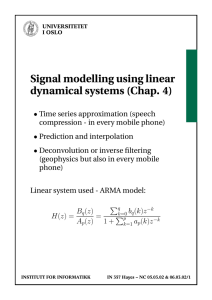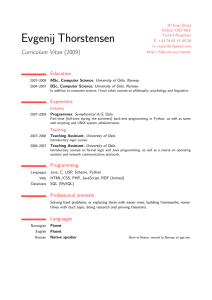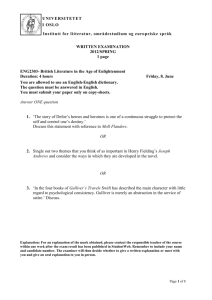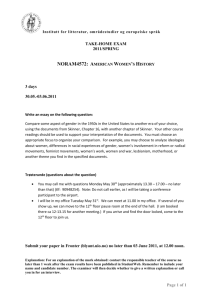Time-series modeling in ecology: a synoptic overview Nils Chr. Stenseth
advertisement
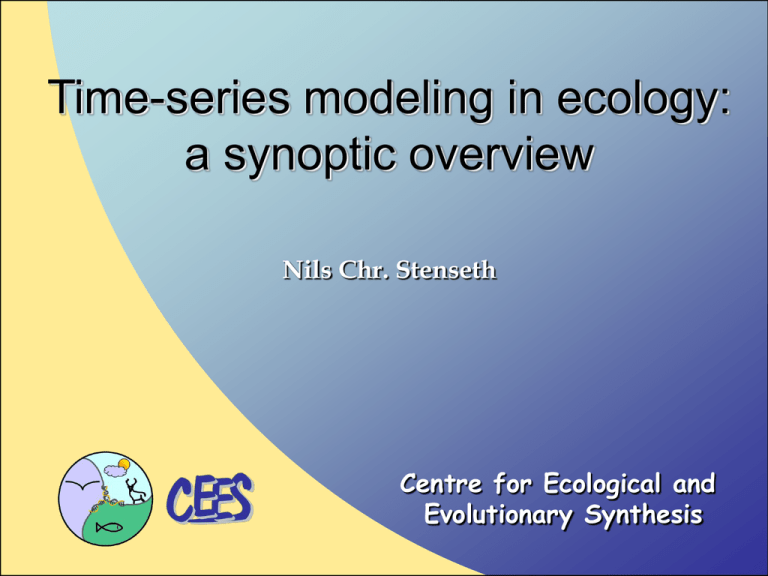
Time-series modeling in ecology: a synoptic overview Nils Chr. Stenseth Centre for Ecological and Evolutionary Synthesis Outline 1. The British Ecologist, Charles Elton – the first ecologist to appreciate the importance of long-term monitoring ecological data. 2. The Canadian lynx. 3. Vole, mice and lemmings. 4. The Soay sheep off the coast of Scotland. 5. Statistical modeling of long-term monitoring data. 6. A French-Norwegian data bank for ecological data Matematisk Institutt, Oslo (05.04.05) Charles Sutherland Elton (March 29, 1900 - May 1, 1991) Matematisk Institutt, Oslo (05.04.05) Elton: a zoologist – and the founding father of (modern) ecology • Lemmings – the Norwegian lemming – and long-term data on abundance of lemmings – played a key role in his intellectual development • Julian Huxley invited him as a field assistant to Spitsbergen/Svalbard in 1921 – the first of several expeditions “… I did go, and the experience had a profound influence upon my ideas in ecology …” • While returning from Spitzbergen in September 1923: “I bought a book in a Tromsø shop that changed my whole life. It was bought with one of the three pounds I had left in my pocket – Robert Collett’s ‘Norges Pattedyr’ (=Norwegian Mammals) .. it was the part about lemmings that enthralled me”. Spitzbergen Tromsø Oxford Matematisk Institutt, Oslo (05.04.05) Lemming and vole cycles lemmings In the Bible: “..swarms of grasshoppers sweeping over the country ..” 14th century A frustratingly distinct pattern with an ennoyingly elusive explanation Begon, 1998 From Olaus Magnus (1555) A Description of the Northern Peoples Matematisk Institutt, Oslo (05.04.05) But much story telling and myths around the lemmings and the lemming/vole cycles - raining from the sky - returning to Atlantis: a debate between Crotch and Collett in the pages of Nature in 1876 - Walt Disney in Barrow [Biology today (1971)] - Donald Duck in the Norwegian fjords. The Norwegian fiords are well known Donald Duck is well known But few know that he has watched lemmings running down the from the Norwegian mountains into the Norwegian fjords Matematisk Institutt, Oslo (05.04.05) Elton contributed to make ecology quantitative at the Bureau of Animal Population A definition of ecology: “Ecology is the scientific endeavor aiming at explaining the distribution and abundance – and their changes thereof – of species in space through time by studying the environment of individuals in natural populations” (after CJ Krebs) That is, a quantitative definition of ecology “George” (PH) Leslie: The Leslie population matrix and Capture-Mark-Recapture modelling (e.g., Caswell 2003) Matematisk Institutt, Oslo (05.04.05) Matematisk Institutt, Oslo (05.04.05) Lynx time series 1920-1994 1820-1940 Stenseth et al., Proc. Natl. Acad. Sci. 1998 Matematisk Institutt, Oslo (05.04.05) Snowshoe hare and lynx are highly interconnected – but can we (through a second order autoregressive model) considerer only one of the species – and believe that we’ve gotten a “full” understanding of the dynamic interaction in the system? Matematisk Institutt, Oslo (05.04.05) X t1 X t11 b1 a11 X t11 a12 X t21 t1 X X 2 t 2 t 1 b2 a21 X 1 t 1 a22 X 2 t 1 2 t Xt = b + (I+A)Xt–1 + t … a second order delay equation in the variable we have data on (typically the lynx) Matematisk Institutt, Oslo (05.04.05) log-transformed time series normalized to mean zero Matematisk Institutt, Oslo (05.04.05) a11 a12 .28 .48 .08 .12 A a a . 26 . 24 . 05 . 07 22 21 11 .48 .08 22 .15 .04 .36 0.10 Matematisk Institutt, Oslo (05.04.05) Matematisk Institutt, Oslo (05.04.05) Fur returns are good proxies for actual abundance Stenseth et al., Proc. Natl. Acad. Sci. 1998 Matematisk Institutt, Oslo (05.04.05) Linearity or non-linearity? What do the data “say”? Matematisk Institutt, Oslo (05.04.05) Predator-prey model with phase-dependence Hares: Ht+1= Ht exp[ai,0 - ai,1xt - ai,2yt] Predators: Pt+1= Pt exp[bi,0 - bi,1yt - bi,2xt] is equivalent to yt = (ai,0bi,2 + ai,1bi,0) + (2 - ai,1 - bi,1)yt-1 + (ai,1 + bi,1 - ai,1bi,1 - ai,2bi,2 - 1)yt-2 + t non-linear Phase dependency: Lower b1,2 yt-2 Upper b2,2 yt-2 threshold model Stenseth et al., Proc. Natl. Acad. Sci. 1998 Matematisk Institutt, Oslo (05.04.05) yt-2 yt-2 Phase-dependence Rochester, Alberta Kluane Lake, Yukon Phase dependency Functional response Stenseth et al., Proc. Natl. Acad. Sci. 1998 Matematisk Institutt, Oslo (05.04.05) Let us ask the lynx (or the data on the lynx)... Is there any spatial structuring of these timeseries data? Matematisk Institutt, Oslo (05.04.05) What is the spatial structuring force(s)? Stenseth et al., Science 1999 Matematisk Institutt, Oslo (05.04.05) Canada divided by climatic regions Stenseth et al., Science 1999 Matematisk Institutt, Oslo (05.04.05) The North Atlantic Oscillation (NAO) the difference in atmospheric pressure between the Azores and Iceland Iceland the Azores Matematisk Institutt, Oslo (05.04.05) The North Atlantic Oscillation (NAO) negative and positive phases low NAO high NAO NAO index 1860-2000 Matematisk Institutt, Oslo (05.04.05) A package of weather - Climate indices Matematisk Institutt, Oslo (05.04.05) Climatic zonation Stenseth et al., Science 1999 Matematisk Institutt, Oslo (05.04.05) This grouping was a result of statistical modeling Stenseth et al., Science 1999 Matematisk Institutt, Oslo (05.04.05) What is the underlying causes of the geographic structuring? Stenseth et al., Science 1999 Matematisk Institutt, Oslo (05.04.05) Difference in frequency of winter warm spells between opposite polarity of the NAO Snow is a key factor for the trophic interaction between hare and lynx ‘X’ = locations (stations) that exhibit statistical significance at the 5% level Stenseth et al., Proc. Natl. Acad. Sci. (2004) Matematisk Institutt, Oslo (05.04.05) … the snow condition may be a key factor in structuring the dynamic interaction between the hare and the lynx Source: Rudolfo's Usenet Animal Pictures Gallery Matematisk Institutt, Oslo (05.04.05) Matematisk Institutt, Oslo (05.04.05) Population studies on voles, mice and lemmings A synoptic account of the legacy of Elton’s work on the cycle problem – particularly on voles, mice and lemmings Matematisk Institutt, Oslo (05.04.05) Population dynamics: cycles and non-cycles A way to summarize small rodent dynamics: Delayed annual density dependence (a2) xt = a1xt-1 + a2xt-2 + t 2-year ’cycles’ Stable 2.0 3.0 4.0 5.0 6.0 Proper multiannual cycles Direct annual density dependence (a1) Matematisk Institutt, Oslo (05.04.05) Cycles & Non-Cycles: a synoptic account (after Stenseth 1999, Oikos) Matematisk Institutt, Oslo (05.04.05) The Fennoscandian gradient Bjørnstad et al. PRSB, 1996. Stenseth et al. PRSB, 1996. Matematisk Institutt, Oslo (05.04.05) A continental European gradient Tkadlec & Stenseth PRSB, 1996. Matematisk Institutt, Oslo (05.04.05) Grey-sided voles in Hokkaido Stenseth et al. PRSB, 1996; Stenseth et al. Res Pop Ecol, 1998. Stenseth & Saitoh Pop Ecol, 1998. Stenseth et al. PRSB, 2002; Stenseth et al. PNAS 2003. Matematisk Institutt, Oslo (05.04.05) Grey-sided voles in Hokkaido and seasonal forcing • the density dependent structure differ between seasons • the variation in density dependences among sites is – it seems – fully accounted for by the length of the seasons • long winters tend to generate cycles Stenseth et al. Res Pop Ecol, 1998. Stenseth et al. PRSB, 1999. Matematisk Institutt, Oslo (05.04.05) Vole, Mice and Lemmings: some conclusions 1. Populations within a given species might be both cyclic and non-cyclic. 2. Typically there are geographic gradients in the periodic structure. 3. Statistical work lead us to understand that the relative length of the seasons might determine whether cycles or non-cycles occur. Matematisk Institutt, Oslo (05.04.05) Modelling the effect(s) of climate fluctuations on population dynamics …some theoretical background Matematisk Institutt, Oslo (05.04.05) Single-species dynamics Nt R N t 1 b 1 (aN t ) R 1 (aN t ) b 0.25 0.2 0.15 0.1 low b 0.05 high b 0 0 2 4 6 8 10 Matematisk Institutt, Oslo (05.04.05) Nt Single-species dynamics Nt R N t 1 1 (aN t ) b Matematisk Institutt, Oslo (05.04.05) Single-species dynamics How to incorporate climatic variability in population dynamic models: - additively… (ii) Density dependence and climate, non-interactive (additive) effects Climt Xt Xt+1 = Xt·R(Xt, Climt) xt+1 = a0 + (1 + a1)·xt + g(Climt) + t+1 Additive effect of climate …or non-additively (iii) Density dependence and climate, interactive effects Xt Climt Xt+1 = Xt·R(Xt, Climt) xt+1 = a0 + [1 + a1(Climt)]·xt + t+1 Climate affecting strength of DD Matematisk Institutt, Oslo (05.04.05) Mathematical and statistical modeling Maynard-Smith – Slatkin model Nt = Nt-1(R0/1+(Nt-1/K)b t Statistical model xt = a0 + a1(xt-1 - k) + 1,t if xt-1 k a0 + a2(xt-1 - k) + 2,t if xt-1 > k …generalized statistical model (iii) Density dependence and climate, interactive effects Xt Climt Xt+1 = Xt·R(Xt, Climt) xt+1 = a0 + [1 + a1(Climt)]·xt + t+1 Climate affecting strength of DD Much statistical work needs to be done – and is been done Matematisk Institutt, Oslo (05.04.05) Single-species dynamics with climate effect (here: NAO) Nt R Nt+1 = 1+(aNt )b(NAO) exp(κ) • Non-additive effect of climate • Non-linear intrinsic and extrinsic processes Using a piecewise linear model (FCTAR) for estimating parameters and functions Matematisk Institutt, Oslo (05.04.05) Single-species dynamics: possible effects of changing climate Nt R Nt+1 = 1+(aNt )b(NAO) b(NAO) Matematisk Institutt, Oslo (05.04.05) An example: the soay sheep off the coast of Scotland - one single species Matematisk Institutt, Oslo (05.04.05) Matematisk Institutt, Oslo (05.04.05) The effect of climatic fluctuation on population dynamics Soay sheep at Hirta, St Kilda Number of individuals 2500 2000 1500 1000 500 0 1955 1965 1975 1985 1995 Year 6 4 NAO 2 0 -2 -4 -6 1955 1965 1975 1985 1995 Matematisk Institutt, Oslo (05.04.05) Results Soay sheep: dynamics depend on NAO Using a FCTAR non-linear and non-additive model Stenseth et al. (2004) Matematisk Institutt, Oslo (05.04.05) Soay sheep: dynamics depend on NAO Low NAO High NAO Matematisk Institutt, Oslo (05.04.05) Nt R Nt+1 = 1+(aNt )b(NAO) Soay sheep: some conclusions 1. There is a clear density dependent structure due to within population interaction. 2. The strength of this density dependency is affected by climate. 3. Hence, climate may influence the dynamics properties of the population. Matematisk Institutt, Oslo (05.04.05) Long-term ecological time series, ecology and statistical modeling Matematisk Institutt, Oslo (05.04.05) Elton and the Oxford Bureau A great naturalist who founded modern ecology and by so doing stated the development of making ecology a quantitative field Observational field studies Providing important long term data series… Time series on total count Time series on individuals Matematisk Institutt, Oslo (05.04.05) … long-term ecological data need to store in a bank so that others can use them … Matematisk Institutt, Oslo (05.04.05) Valuable data in Hokkaido Matematisk Institutt, Oslo (05.04.05) Banking and maintaining long-term data of two kinds: 1. Open access data-bases: scientists might be reluctant to store their data in such an open bank – and users might not obtain the proper background information for using the stored data properly 2. Rather, the data should be stored in what resembles old traditional museums (with staff members, i.e., curators, which can provide background knowledge about the stored data) Matematisk Institutt, Oslo (05.04.05) Open access web-based data bases Matematisk Institutt, Oslo (05.04.05) Such a data-bank should be organized according the principles of our traditional museums … but should take fully advantage of mordern computer technology Matematisk Institutt, Oslo (05.04.05) We need to save such data files This we must avoid! Matematisk Institutt, Oslo (05.04.05) 40 F. Finse, Norway: Norwegian lemming, L. lemmus 35 30 25 20 15 10 5 0 1945 1955 1965 1975 1985 1995
